|
Sweet wines, those made from dried grapes, as well as fortified wines, belong
to less consumed style by modern consumers. Once considered as medical remedies
for the treatment and rehabilitation of patients, sweet wines were always found
in the tables of noble and wealth people, in particular to show off their
wealthy status. Very expensive wines - something true for quality wines and
those really made from dried grapes - they made the glory of certain wine areas
of the world, a fame that, in many cases, is still alive today. It is enough to
name a couple of them - Sauternes and Tokaji - in order to evoke in many wine
lovers' mind the idea of an excellent nectar, both emblems of very high and
historical quality. It must be said, for the sake of truth, most of the charm
of these wines is also thanks to the effects of Botrytis Cinerea - also
known as noble rot - capable of enriching the elegance of these wines.
The decline of these prestigious wines is also because of the change of taste
and fads of our times, in which dry wines represent the main wine making model.
Sweet wines made from dried grapes and, even more, those made from grapes
affected by noble rot, represent a quite demanding wine making task. Last but
not the least, it is something quite expensive as well, because what you get
from dried grapes is far lesser than what you get by making table wines. In
general terms, dried grapes lose a significant quantity of water - and
therefore juice - something which can also be more than 40% of weight, then
making a far lesser quantity of wine. Despite of modern trends in consumption,
sweet wines made from dried grapes represent one of the most complex and
amazing sensorial exercises for any taster. The complexity of these wines is in
fact the most demanding task any taster can experience from his or her glass.
Sicily is a land of great sweet wines made from dried grapes. In this island
are in fact made some of the most famous sweet wines of Italy, such as the
renowned Passito di Pantelleria, Malvasia delle Lipari and Moscato di Siracusa.
Sicily seems to be particularly suited for the production of this style of
wines, not only for the generosity of sun, but also for the varieties
particularly suited for the making of sweet wines. Protagonist of sweet
Sicilian wines certainly is Moscato di Alessandria - known in the island as
Zibibbo - which, besides being used for Passito di Pantelleria, is also
found in many IGT sweet wines of the region. Coming from Egypt, Moscato di
Alessandria was introduced in Sicily by Phoenicians and since then used for
the production of sweet wines. Moscato di Alessandria seems to be so well
suited for the production of sweet wines that even the name used in Sicily to
call this grape can confirm that.
The term Zibibbo in fact derives from Arab zabib, meaning “dried
grape”, confirming the use they have always made from this variety, that is
allowed to dry and consumed as a dried fruit or vinified. The best land for
Moscato di Alessandria certainly is the charming Pantelleria island, the place
where it is made the renowned “passito”, an absolute excellence of Sicilian
and Italian wine making. Here vineyards, cultivated with the alberello
technique, have a charming and particular character, cultivated in the typical
terracing, a technique introduced by Arabs in this island. A viticultural
practice unique and special, for which UNESCO wanted to nominate the
“traditional agricultural practice of cultivating the vite ad alberello
(head-trained bush vines) of the community of Pantelleria, as heritage of
humanity. From these precious vineyards is being harvested Zibibbo grape and,
after having properly dried under the sun, it is crushed and made a very sweet
and dense must, used for the production of Passito di Pantelleria.
Far from Pantelleria, we find another place where it is practiced a charming
viticulture, that is the land of Cinque Terre, in province of La Spezia,
Liguria. For the specific beauty of the place, coastlines, hillsides and how
man has been capable of taking advantage of the nature of these places, Cinque
Terre have been nominated by UNESCO as a World Heritage Site. In these lands are
produced white wines with Bosco, Albarola and Vermentino grapes, including the
famous Sciacchetrà, one of the most looked for and rare sweet wines made from
dried grapes in Italy. Vineyards are cultivated in very steep terracing -
pieces of land adapted from the wild nature - and vines are cultivated as
bushes, a typical practice in areas characterized by strong wind. Viticulture
and harvesting are done in quite extreme conditions as to require, in certain
cases, the use particular monorail carriages running along the steep and rugged
sides sloping down to the sea.
In these lands, adapted from the severity of nature in order to allow the
cultivation of vine, are harvested the precious grapes that, after having been
properly dried, give life to the rare and precious Cinque Terre Sciacchetrà.
The production of this wine is very low, also by considering the grapes
cultivated in Cinque Terre are also used for dry white wines. Having a deep
golden color, sometimes intense amber as well, Sciacchetrà is a sweet wine of
rare elegance and complexity. This characteristic is also the result of the
minimum aging time set by the production disciplinary and which must be of at
least one year, at least until the first day of November of the next year
following harvesting. Sciacchetrà is a rare wine and, maybe, also because of
the limited interest for sweet wines of our times, it does not benefit from the
fame of other wines belonging to the same category. This precious wine of
Liguria however represents one of the highest and more prestigious excellences
of Italian and worldwide wine making.
|
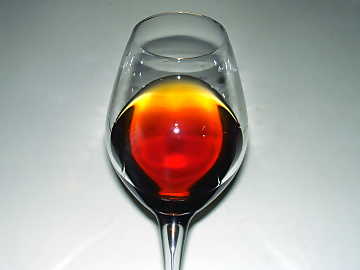 | |
| The color of Cinque Terre
Sciacchetrà observed by tilting the glass | |
|
The wines we will choose for our tasting will belong to the same vintage and
must not however be older than two years. We should notice, first of all,
Sciacchetrà is produced with three grapes - Bosco, Albarola and Vermentino -
whereas Passito di Pantelleria is made from just one: Zibibbo. Moreover, it
should be said that, as opposed to Moscato di Alessandria, the three varieties
used for Sciacchetrà are not aromatic. We should also notice in the production
of Sciacchetrà is usually favored a higher percentage of Bosco grape because of
the thickness of its skin, a characteristic limiting the breaking of berries. A
fundamental factor allowing the use of sound berries, as opposed to what
happens when grapes having a thin skin are used instead. Wines will be poured
in two glasses and tasted at the temperature of 15 °C (59 °F), in order to
ensure the proper development of organoleptic qualities without favoring the
excessive perception of sweetness.
Let's pour the two wines in their respective glasses and begin our tasting by
contrast from the analysis of appearance. Sweet wines produced with dried
grapes have a special and noble appearance since the very moment we evaluate
color. In these wines hues are deep and brilliant, also getting elegant golden
colors and even amber. Wines of our tasting are no exception to this
characteristic. Passito di Pantelleria shows in fact an intense and deep golden
color, almost amber, with evident nuances of golden yellow. The appearance of
Cinque Terre Sciacchetrà is, in general terms, deeper while showing an evident
intense amber yellow color. Nuances, observed by tilting the glass and by
evaluating the wine to the edge towards the opening, shows hues of the same
color. The two wines show a good transparency, not so high, however allowing
seeing the object put behind the glass.
The evaluation of the olfactory profile certainly represents the most amazing
and extraordinary part of the sensorial tasting of sweet wines made from dried
grapes. Dense aromas, complex, sometimes complicated, sweet wines made from
dried grapes - when produced with quality criteria - offer to the taster one of
the highest educational exercise possible. So different from the typical aromas
of table wines - and they too are of course charming - the evaluation of the
olfactory profile of sweet wines produced with dried grapes requires a lot of
concentration and attention. The richness of these wines is given both by the
use of dried grapes - a process that, as a matter of fact, concentrates the
juice inside the berry - as well as time and aging. These wines, besides being
capable of aging for many years and becoming, at the same time, more complex,
are usually sold after many months, even years, from harvesting.
Let's proceed with the olfactory analysis of the two wines. By keeping the
glasses in vertical position and without swirling, let's proceed with the
preliminary smell of the two wines. Let's smell the glass of Passito di
Pantelleria and, after that, the one of Cinque Terre Sciacchetrà: the aromatic
difference of the two wines is evident. Moscato di Alessandria - or Zibibbo -
offers to the nose an aromatic character similar to grape juice, whereas in
Sciacchetrà this characteristic seems to be absent, while perceiving a strong
aroma of raisin. Both wines offer to the nose a complex character in which can
be perceived aromas of dried fruits, including dried fig, date and raisin. In
Passito di Pantelleria can be perceived almond, whereas in Cinque Terre
Sciacchetrà will be found walnut, while having in common candied fruits, honey
and citrus fruit peel. Passito di Pantelleria sometimes offer to the nose
aromas of lychee, lavender and aromatic herbs, including sage and thyme. In
both wines can be perceived strong aromas of white and yellow fruit jams, in
particular apricot and peach.
The taste of Passito di Pantelleria and Cinque Terre Sciacchetrà seem to have
more common characteristics instead of contrasts. The attack of the two wines,
something obviously happening in this style, is characterized by an evident
sweetness. The must used for the production of these wines is, as a consequence
of the drying of grapes, very concentrated and dense, therefore in the mouth is
perceived a full and robust structure. To this is also added a pleasing
roundness and, for certain aspects, this is unavoidable, a characteristic
increasing the pleasingness of these wines. Also alcohol, found in significant
quantities in both wines, contributes to the increasing of sweetness and
roundness, despite it plays a role in the balance of wine with its burning
sensation. The fundamental element in these wines in order to reach a proper
balance is represented by acidity, a factor making a sweet wine pleasing and
elegant or sickly-sweet. In both wines it is in fact perceived a remarkable
acidity: not just a pleasing sensation but also an essential factor for balance.
Another amazing characteristic of sweet wines produced with dried grapes
certainly is the finish, made of the sensations the wine leaves in the mouth
after swallowing. The persistence of Passito di Pantelleria and Cinque
Terre Sciacchetrà is very good, wines that - on this regard - will never
disappoint with a very long finish. Both wines leave in the mouth a sensation
of balance, in which can be perceived both sweetness and roundness, balanced by
a pleasing acidity. The difference in these wines is expressed by the flavors
perceived in the mouth. In Passito di Pantelleria can be appreciated the
characteristic flavor of grape and dried apricot, whereas in Cinque Terre
Sciacchetrà can be mainly perceived raisin, dried fig and honey, an undoubtedly
elegant finish in both cases. Two great wines, coming from two charming lands
in which viticulture represents - for certain aspects - a challenge between man
and nature, capable of making divine nectars, generous of high and noble
emotions.
|


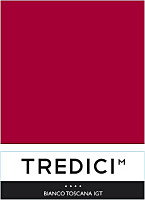
 Moscato Bianco
Moscato Bianco Brilliant straw yellow and nuances of greenish yellow, very
transparent.
Brilliant straw yellow and nuances of greenish yellow, very
transparent.
 Intense, clean, pleasing and refined, starts with hints of grape, peach
and lychee followed by aromas of apple, pear, lemon, orange blossom and
sage.
Intense, clean, pleasing and refined, starts with hints of grape, peach
and lychee followed by aromas of apple, pear, lemon, orange blossom and
sage.
 Crisp attack and however balanced by alcohol, good body, intense
flavors, pleasing roundness.
Crisp attack and however balanced by alcohol, good body, intense
flavors, pleasing roundness.
 Persistent finish with flavors of grape, peach and lychee.
Persistent finish with flavors of grape, peach and lychee. 6 months in steel tanks.
6 months in steel tanks. Pasta and risotto with crustaceans, Broiled crustaceans, Stewed fish, Cheese
Pasta and risotto with crustaceans, Broiled crustaceans, Stewed fish, Cheese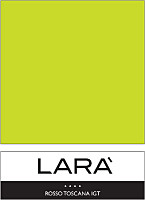
 Merlot, Syrah
Merlot, Syrah Intense ruby red and nuances of ruby red, little transparency.
Intense ruby red and nuances of ruby red, little transparency. Intense, clean, pleasing and refined, starts with hints of black
cherry, black currant and plum followed by aromas of blueberry, violet,
blackberry and carob.
Intense, clean, pleasing and refined, starts with hints of black
cherry, black currant and plum followed by aromas of blueberry, violet,
blackberry and carob.
 Properly tannic attack and however balanced by alcohol, good body,
intense flavors, pleasing roundness.
Properly tannic attack and however balanced by alcohol, good body,
intense flavors, pleasing roundness.
 Persistent finish with flavors of plum, black currant and black cherry.
Persistent finish with flavors of plum, black currant and black cherry. 8 months in steel tanks.
8 months in steel tanks. Stuffed pasta, Roasted meat, Broiled meat and barbecue, Stewed meat
Stuffed pasta, Roasted meat, Broiled meat and barbecue, Stewed meat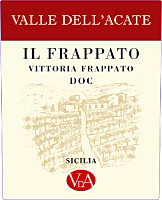
 Frappato
Frappato Brilliant ruby red and nuances of ruby red, moderate transparency.
Brilliant ruby red and nuances of ruby red, moderate transparency. Intense, clean, pleasing and refined, starts with hints of cherry,
blackberry and raspberry followed by aromas of strawberry, violet, plum,
cyclamen and blueberry.
Intense, clean, pleasing and refined, starts with hints of cherry,
blackberry and raspberry followed by aromas of strawberry, violet, plum,
cyclamen and blueberry.
 Properly tannic attack and however balanced by alcohol, good body,
intense flavors, intense flavors, pleasing crispness.
Properly tannic attack and however balanced by alcohol, good body,
intense flavors, intense flavors, pleasing crispness.
 Persistent finish with flavors of cherry, blackberry and raspberry.
Persistent finish with flavors of cherry, blackberry and raspberry. 6 months in steel tanks, 3 months in bottle.
6 months in steel tanks, 3 months in bottle. Cold cuts, Pasta with meat, Sauteed meat, Fish soups
Cold cuts, Pasta with meat, Sauteed meat, Fish soups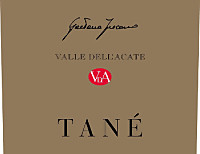
 Nero d'Avola, Syrah
Nero d'Avola, Syrah Brilliant ruby red and nuances of brick red, moderate transparency.
Brilliant ruby red and nuances of brick red, moderate transparency. Intense, clean, pleasing and refined, starts with hints of prune,
blackberry jam and dried violet followed by aromas of black cherry jam,
carob, vanilla, chocolate, tobacco, mace and menthol.
Intense, clean, pleasing and refined, starts with hints of prune,
blackberry jam and dried violet followed by aromas of black cherry jam,
carob, vanilla, chocolate, tobacco, mace and menthol.
 Properly tannic attack and however balanced by alcohol, good body,
intense flavors, pleasing roundness.
Properly tannic attack and however balanced by alcohol, good body,
intense flavors, pleasing roundness.
 Persistent finish with flavors of prune, blackberry jam and black
cherry jam.
Persistent finish with flavors of prune, blackberry jam and black
cherry jam.
 12 months in barrique, 14 months in bottle.
12 months in barrique, 14 months in bottle. Roasted meat, Broiled meat and barbecue, Stewed and braised meat with mushrooms, Hard cheese
Roasted meat, Broiled meat and barbecue, Stewed and braised meat with mushrooms, Hard cheese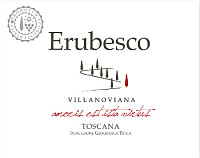
 Merlot (70%), Cabernet Franc (30%)
Merlot (70%), Cabernet Franc (30%) Intense ruby red and nuances of ruby red, little transparency.
Intense ruby red and nuances of ruby red, little transparency. Intense, clean, pleasing and refined, starts with hints of black
currant, black cherry and blueberry followed by aromas of violet,
blueberry, raspberry and carob.
Intense, clean, pleasing and refined, starts with hints of black
currant, black cherry and blueberry followed by aromas of violet,
blueberry, raspberry and carob.
 Properly tannic attack and however balanced by alcohol, good body,
intense flavors, pleasing roundness.
Properly tannic attack and however balanced by alcohol, good body,
intense flavors, pleasing roundness.
 Persistent finish with flavors of black currant, black cherry and
blueberry.
Persistent finish with flavors of black currant, black cherry and
blueberry.
 6 months in cement tanks, 6 months in bottle.
6 months in cement tanks, 6 months in bottle. Stuffed pasta, Broiled meat and barbecue, Stewed meat
Stuffed pasta, Broiled meat and barbecue, Stewed meat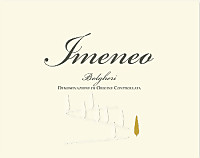
 Merlot (60%), Cabernet Franc (40%)
Merlot (60%), Cabernet Franc (40%) Intense ruby red and nuances of garnet red, little transparency.
Intense ruby red and nuances of garnet red, little transparency. Intense, clean, pleasing and refined, starts with hints of black
currant, black cherry and violet followed by aromas of plum, blueberry,
vanilla, chocolate, tobacco, iris and eucalyptus.
Intense, clean, pleasing and refined, starts with hints of black
currant, black cherry and violet followed by aromas of plum, blueberry,
vanilla, chocolate, tobacco, iris and eucalyptus.
 Properly tannic attack and however balanced by alcohol, good body,
intense flavors, agreeable.
Properly tannic attack and however balanced by alcohol, good body,
intense flavors, agreeable.
 Persistent finish with flavors of black currant, black cherry and plum.
Persistent finish with flavors of black currant, black cherry and plum. 10 months in barrique.
10 months in barrique. Roasted meat, Stewed meat with mushrooms, Hard cheese
Roasted meat, Stewed meat with mushrooms, Hard cheese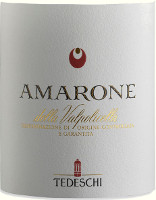
 Corvina (30%), Corvinone (30%), Rondinella (30%), Oseleta, Negrara, Dindarella, Rossignola (10%)
Corvina (30%), Corvinone (30%), Rondinella (30%), Oseleta, Negrara, Dindarella, Rossignola (10%) Intense ruby red and nuances of ruby red, little transparency.
Intense ruby red and nuances of ruby red, little transparency. Intense, clean, pleasing, refined and elegant, starts with hints of
plum, blackberry and black cherry followed by aromas of violet, blueberry,
vanilla, chocolate, mace, tobacco, pink pepper and menthol.
Intense, clean, pleasing, refined and elegant, starts with hints of
plum, blackberry and black cherry followed by aromas of violet, blueberry,
vanilla, chocolate, mace, tobacco, pink pepper and menthol.
 Tannic attack and however balanced by alcohol, full body, intense
flavors, pleasing roundness.
Tannic attack and however balanced by alcohol, full body, intense
flavors, pleasing roundness.
 Persistent finish with flavors of plum, blackberry and black cherry.
Persistent finish with flavors of plum, blackberry and black cherry. 3 years in cask, 6 months in bottle.
3 years in cask, 6 months in bottle. Game, Stewed and braised meat, Roasted meat, Hard cheese
Game, Stewed and braised meat, Roasted meat, Hard cheese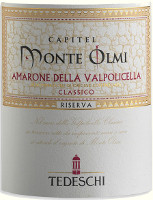
 Corvina (30%), Corvinone (30%), Rondinella (30%), Oseleta, Negrara, Dindarella, Croatina, Forselina (10%)
Corvina (30%), Corvinone (30%), Rondinella (30%), Oseleta, Negrara, Dindarella, Croatina, Forselina (10%) Intense ruby red and nuances of brick red, little transparency.
Intense ruby red and nuances of brick red, little transparency. Intense, clean, pleasing, refined and elegant, starts with hints of
blackberry, plum and dried violet followed by aromas of black cherry,
vanilla, chocolate, blueberry, leather, tobacco, cinnamon, mace and
menthol.
Intense, clean, pleasing, refined and elegant, starts with hints of
blackberry, plum and dried violet followed by aromas of black cherry,
vanilla, chocolate, blueberry, leather, tobacco, cinnamon, mace and
menthol.
 Tannic attack and however balanced by alcohol, full body, intense
flavors, pleasing roundness.
Tannic attack and however balanced by alcohol, full body, intense
flavors, pleasing roundness.
 Very persistent finish with long flavors of blackberry, plum and black
cherry.
Very persistent finish with long flavors of blackberry, plum and black
cherry.
 4 years in cask, 6 months in bottle.
4 years in cask, 6 months in bottle. Game, Stewed and braised meat, Roasted meat, Hard cheese
Game, Stewed and braised meat, Roasted meat, Hard cheese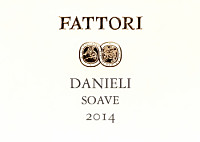
 Garganega
Garganega Pale straw yellow and nuances of greenish yellow, very transparent.
Pale straw yellow and nuances of greenish yellow, very transparent. Intense, clean, pleasing and refined, starts with hints of apple, peach
and plum followed by aromas of pear, citrus fruits, hawthorn, broom,
pineapple and almond.
Intense, clean, pleasing and refined, starts with hints of apple, peach
and plum followed by aromas of pear, citrus fruits, hawthorn, broom,
pineapple and almond.
 Crisp attack and however balanced by alcohol, good body, intense
flavors, agreeable.
Crisp attack and however balanced by alcohol, good body, intense
flavors, agreeable.
 Persistent finish with flavors of apple, pear and peach.
Persistent finish with flavors of apple, pear and peach. Aged in steel tanks.
Aged in steel tanks. Pasta and risotto with fish and crustaceans, Sauteed fish, Vegetable soups
Pasta and risotto with fish and crustaceans, Sauteed fish, Vegetable soups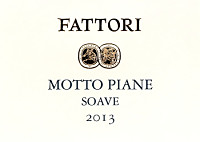
 Garganega
Garganega Intense straw yellow and nuances of straw yellow, very transparent.
Intense straw yellow and nuances of straw yellow, very transparent. Intense, clean, pleasing, refined and elegant, starts with hints of
apple, plum and citrus fruits followed by aromas of pear, broom, peach,
medlar, hawthorn, pineapple, almond, honey, sage and hints of vanilla.
Intense, clean, pleasing, refined and elegant, starts with hints of
apple, plum and citrus fruits followed by aromas of pear, broom, peach,
medlar, hawthorn, pineapple, almond, honey, sage and hints of vanilla.
 Crisp attack and however balanced by alcohol, good body, intense
flavors, pleasing roundness.
Crisp attack and however balanced by alcohol, good body, intense
flavors, pleasing roundness.
 Very persistent finish with long flavors of apple, plum and medlar.
Very persistent finish with long flavors of apple, plum and medlar. Made from Garganega grape and dried for 40 days, aged in steel tanks
and cask.
Made from Garganega grape and dried for 40 days, aged in steel tanks
and cask.
 Pasta and risotto with vegetale and crustaceans, Mushrooms soups, Sauteed white meat, Roasted fish
Pasta and risotto with vegetale and crustaceans, Mushrooms soups, Sauteed white meat, Roasted fish
